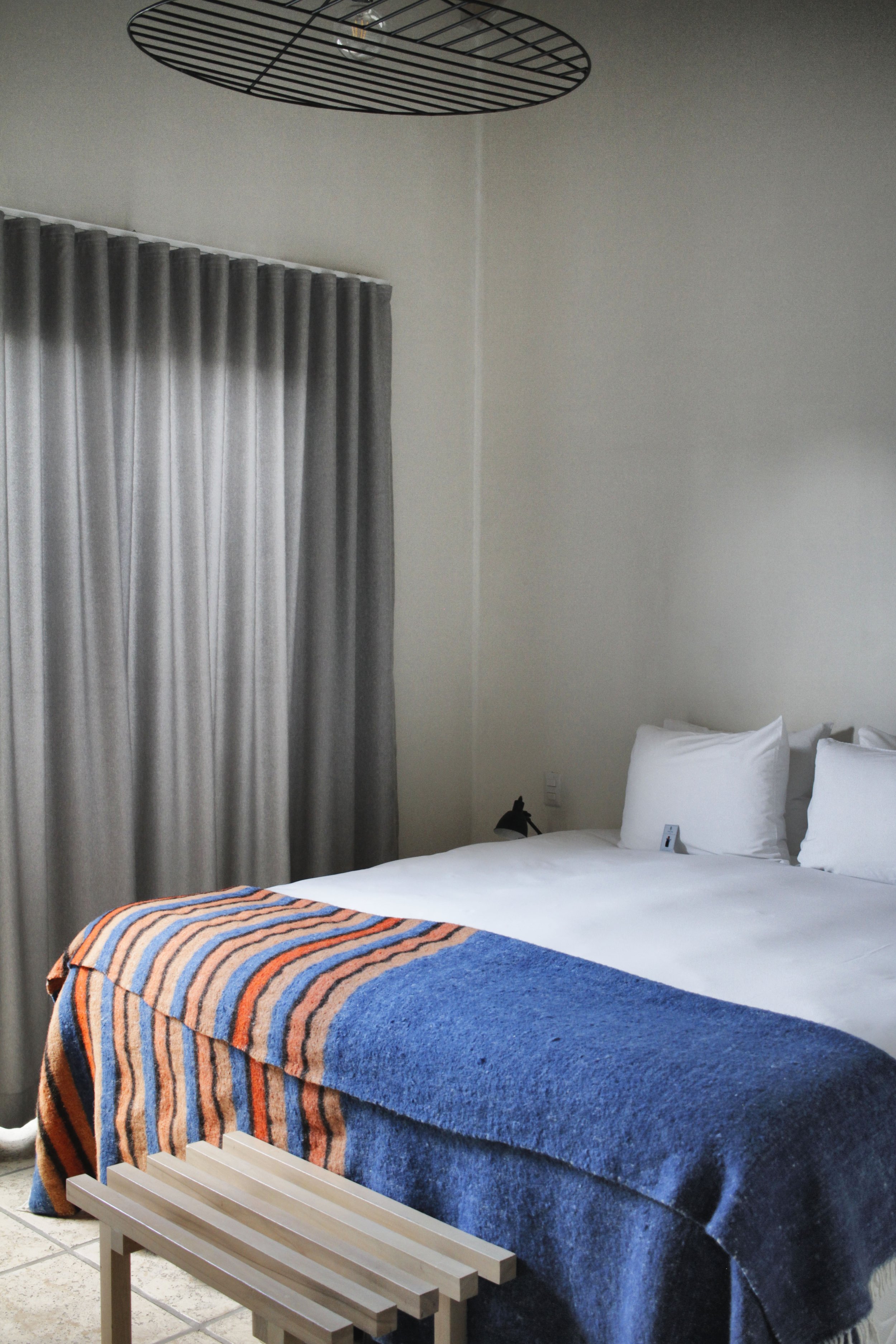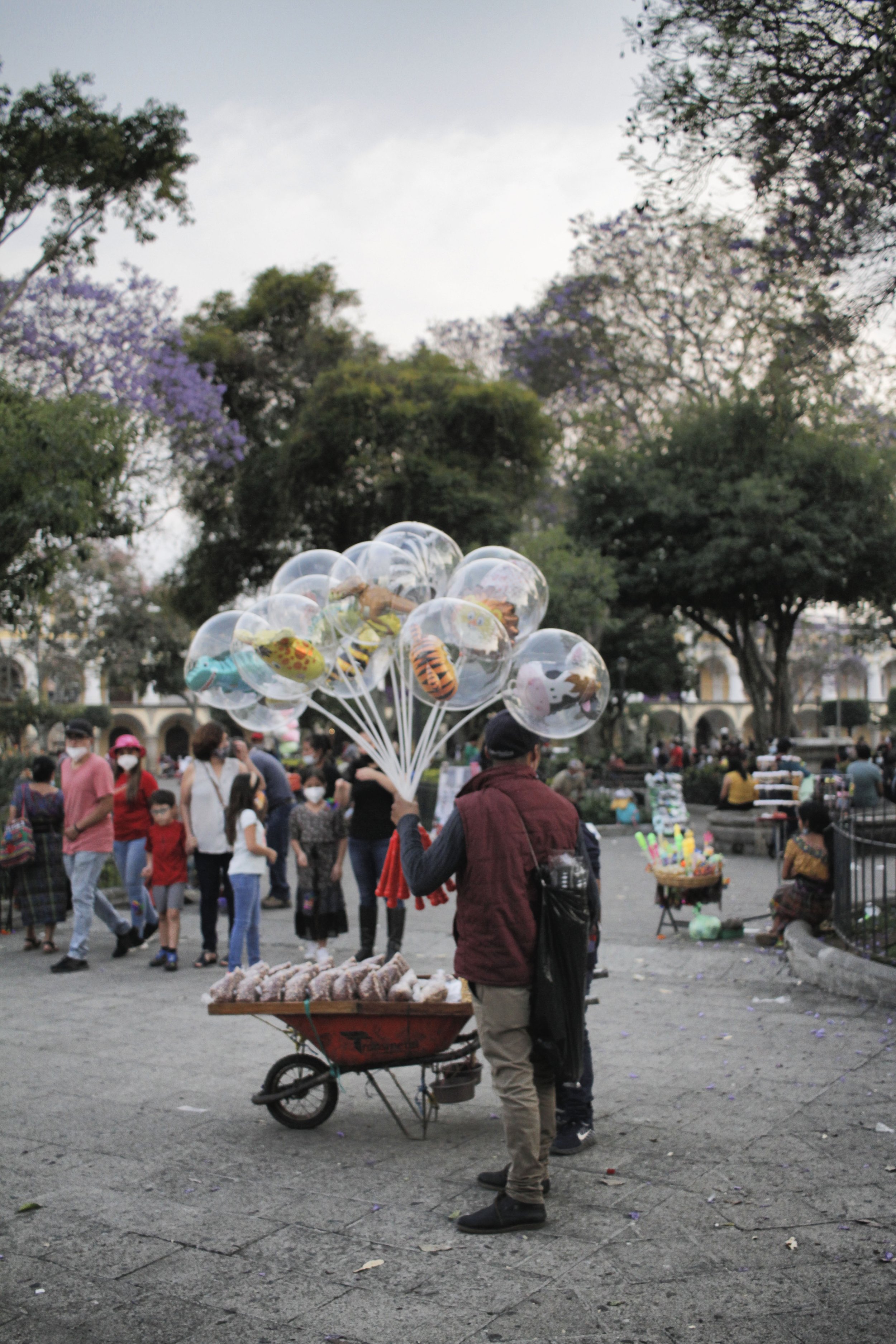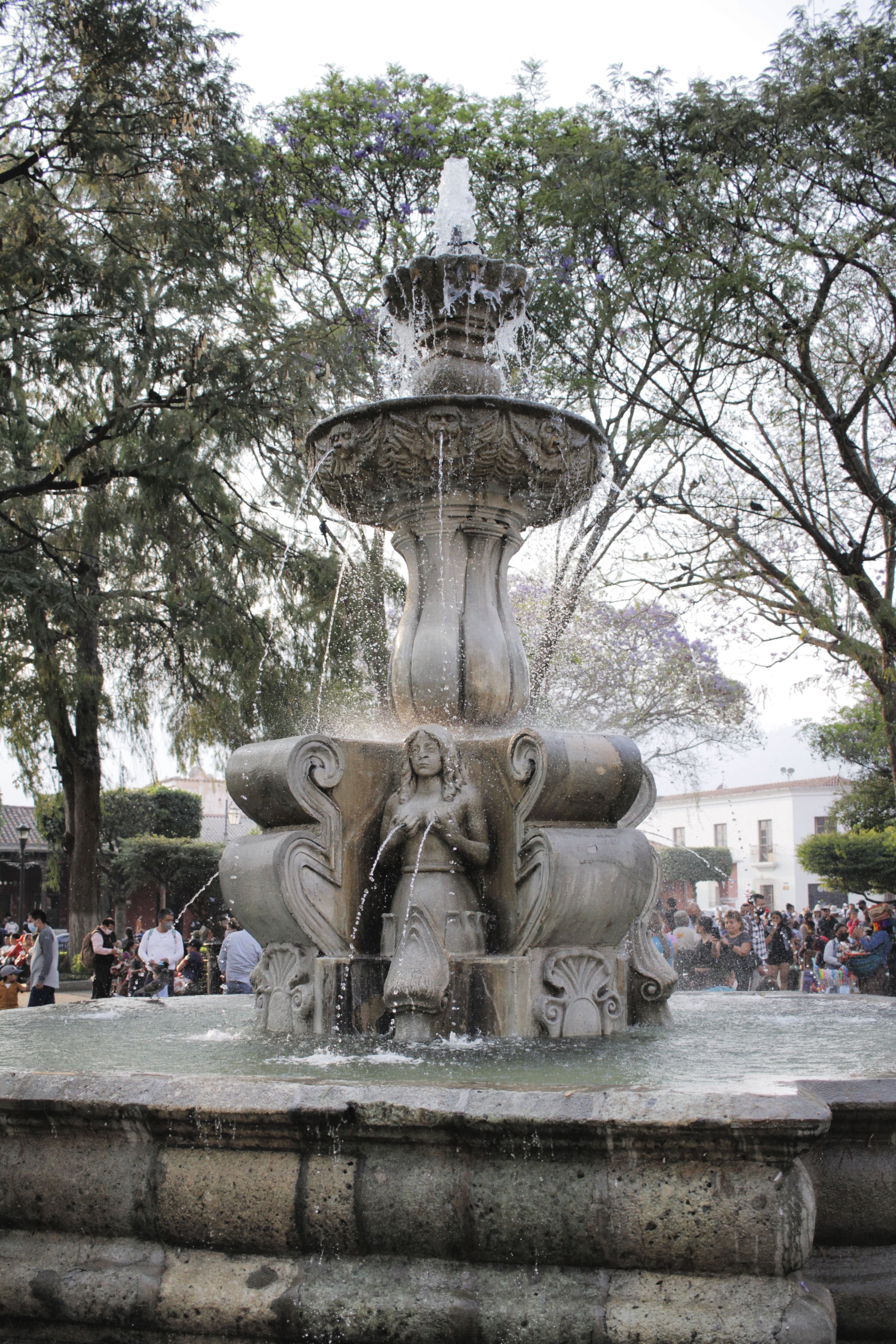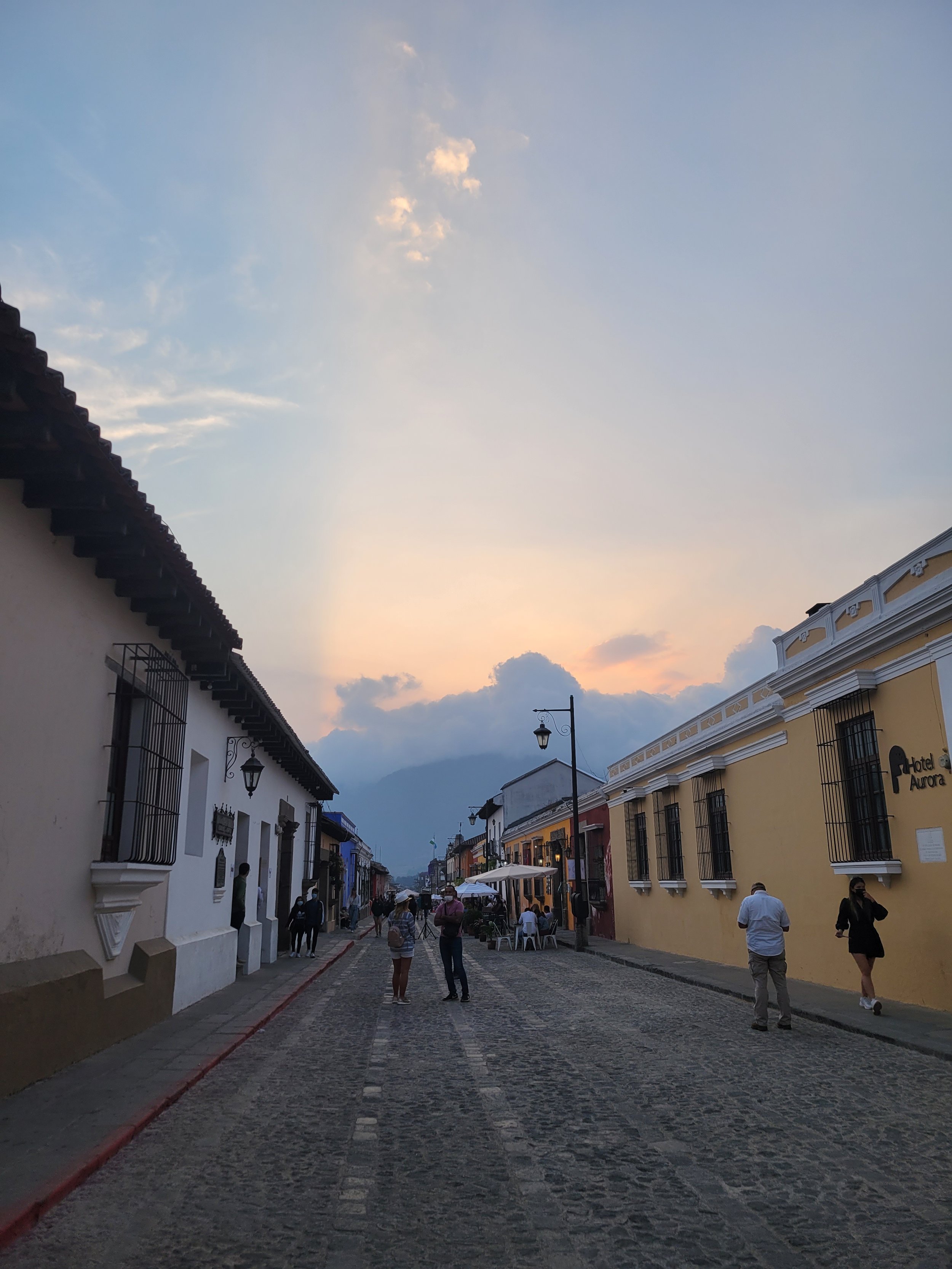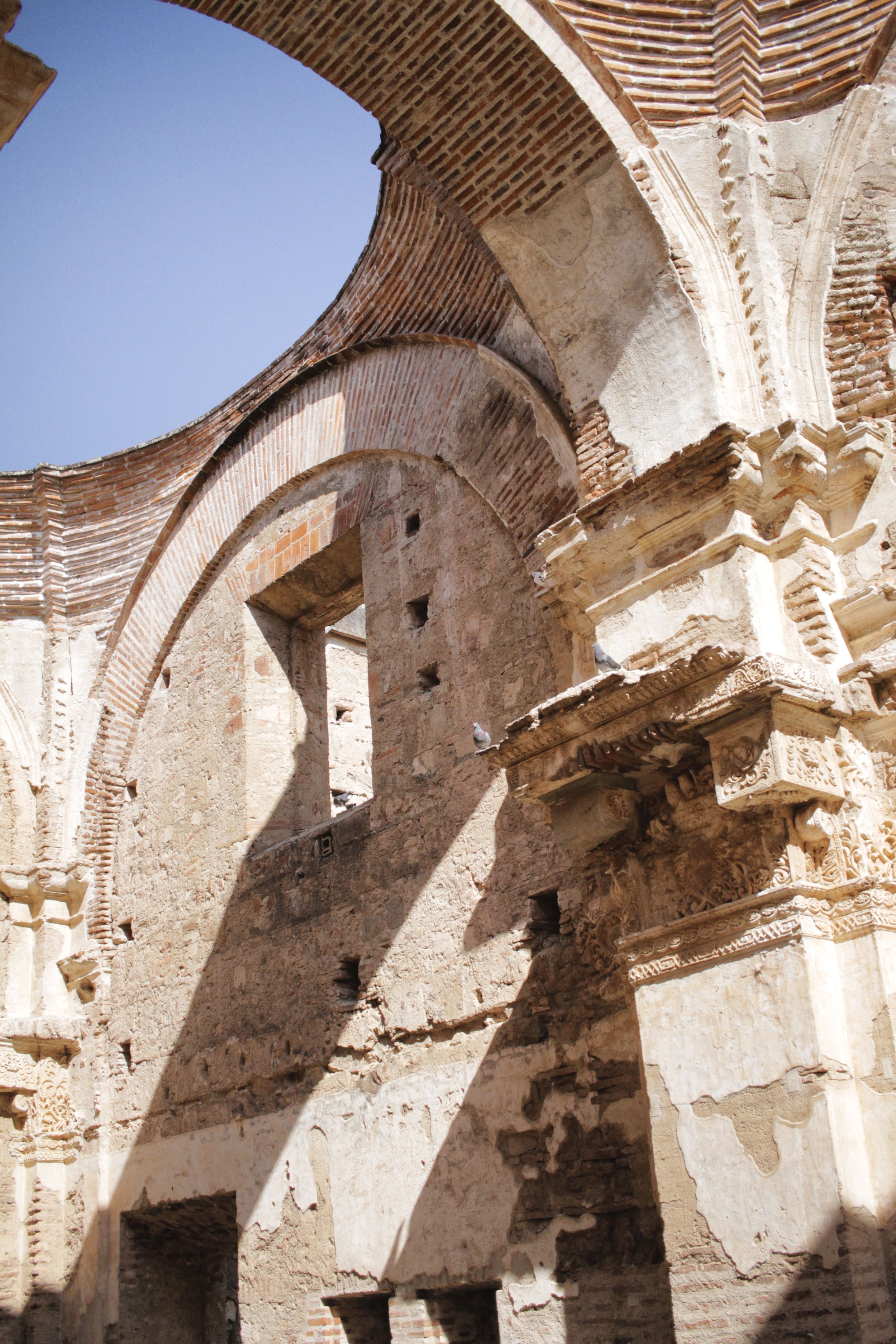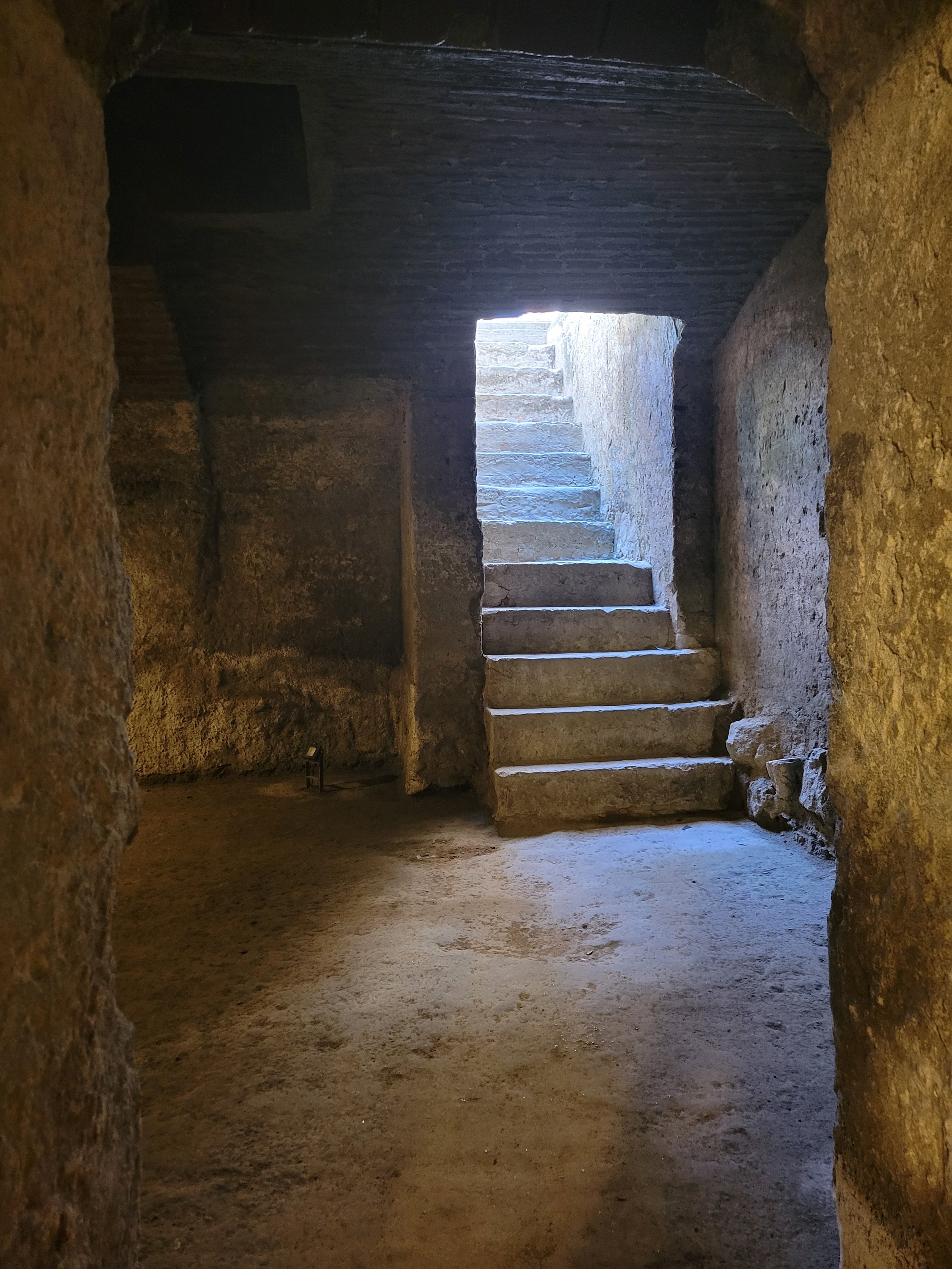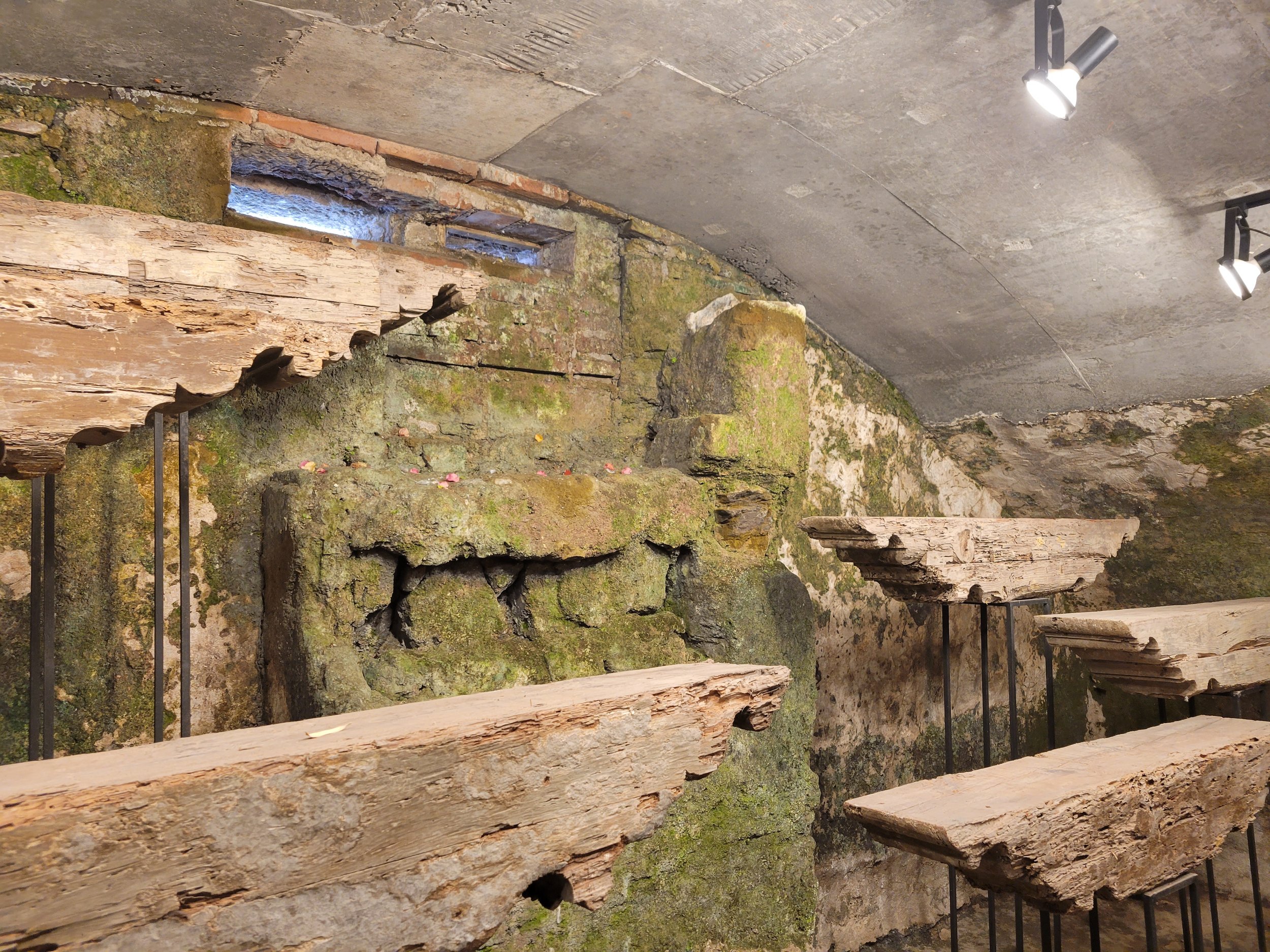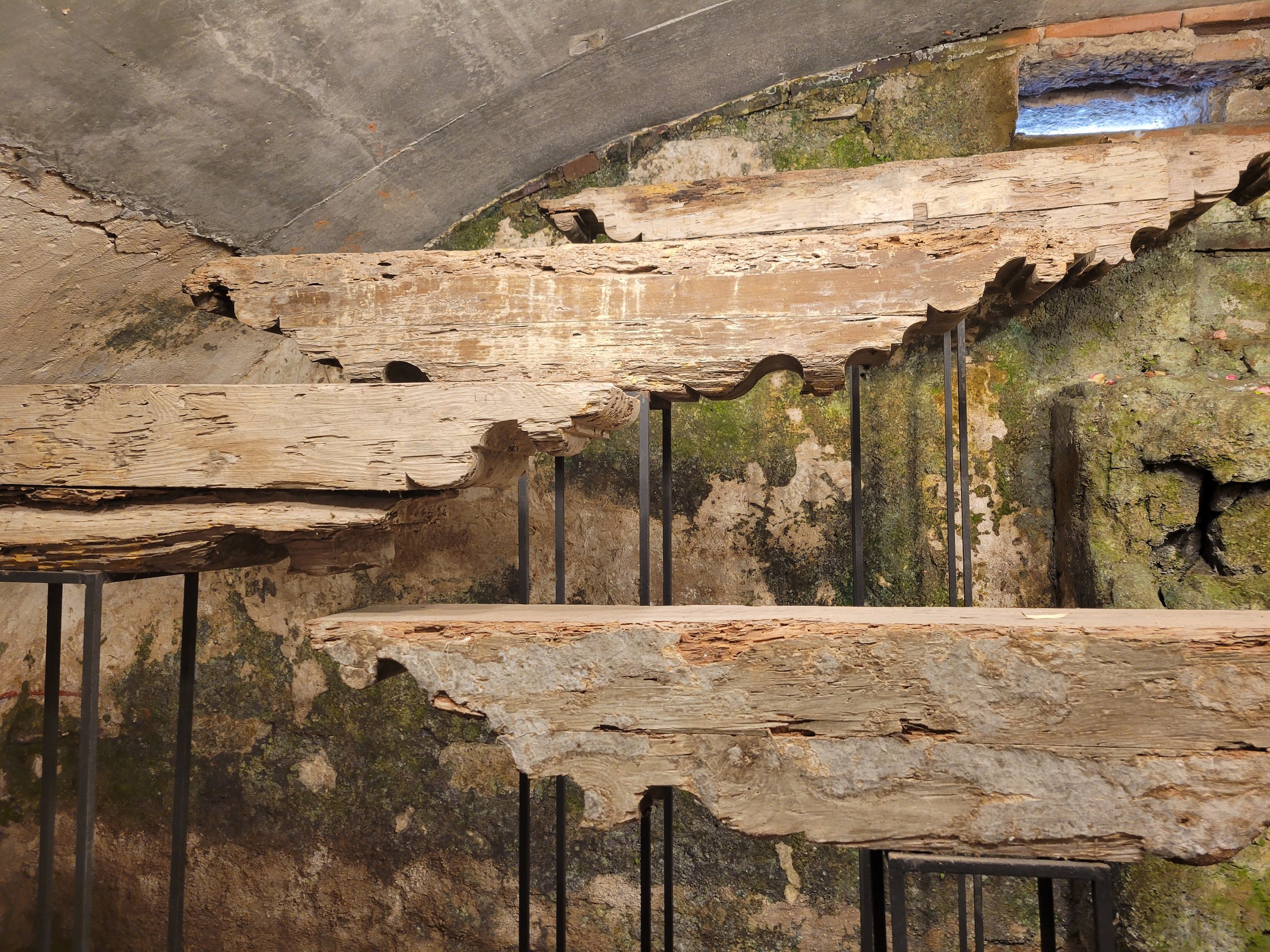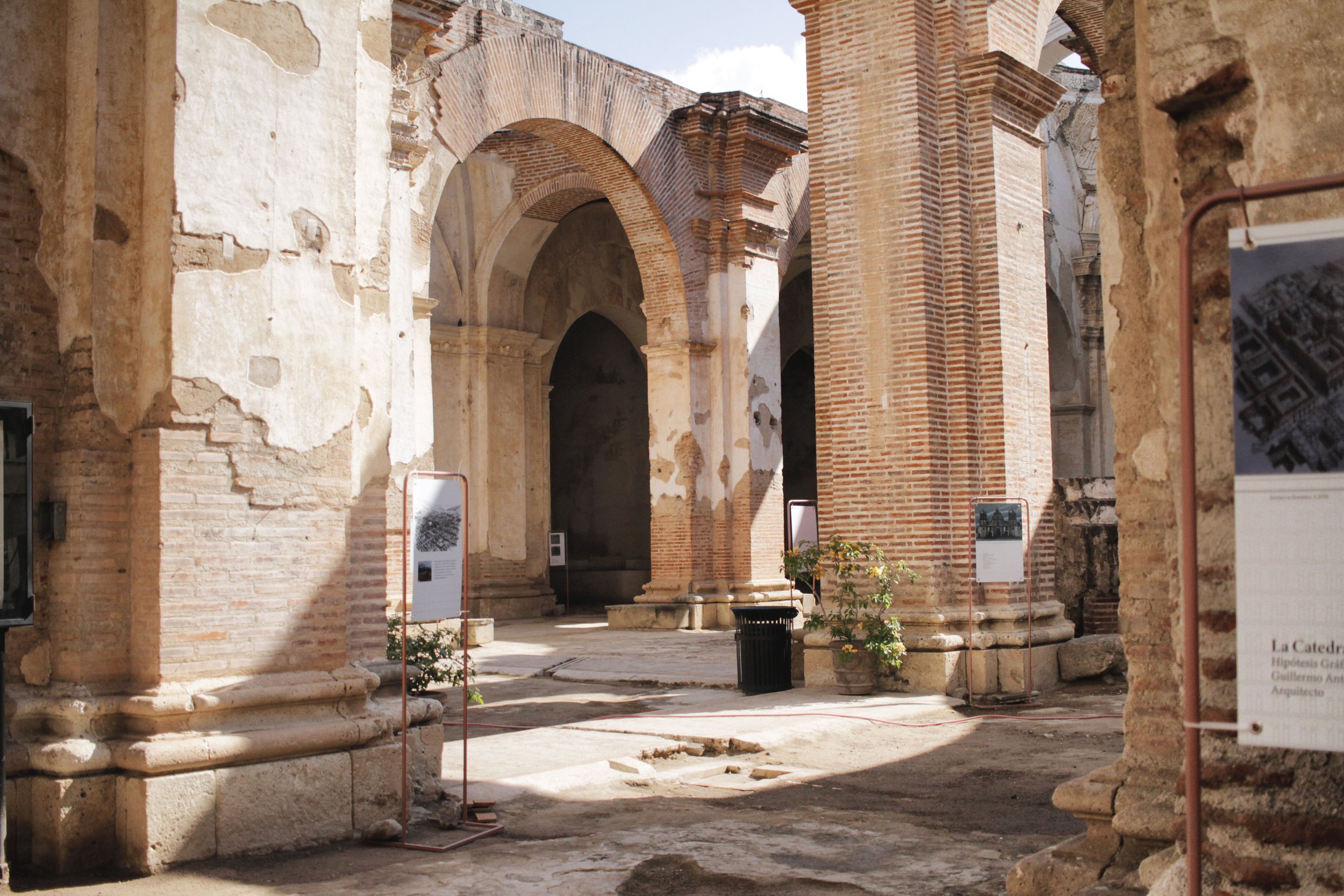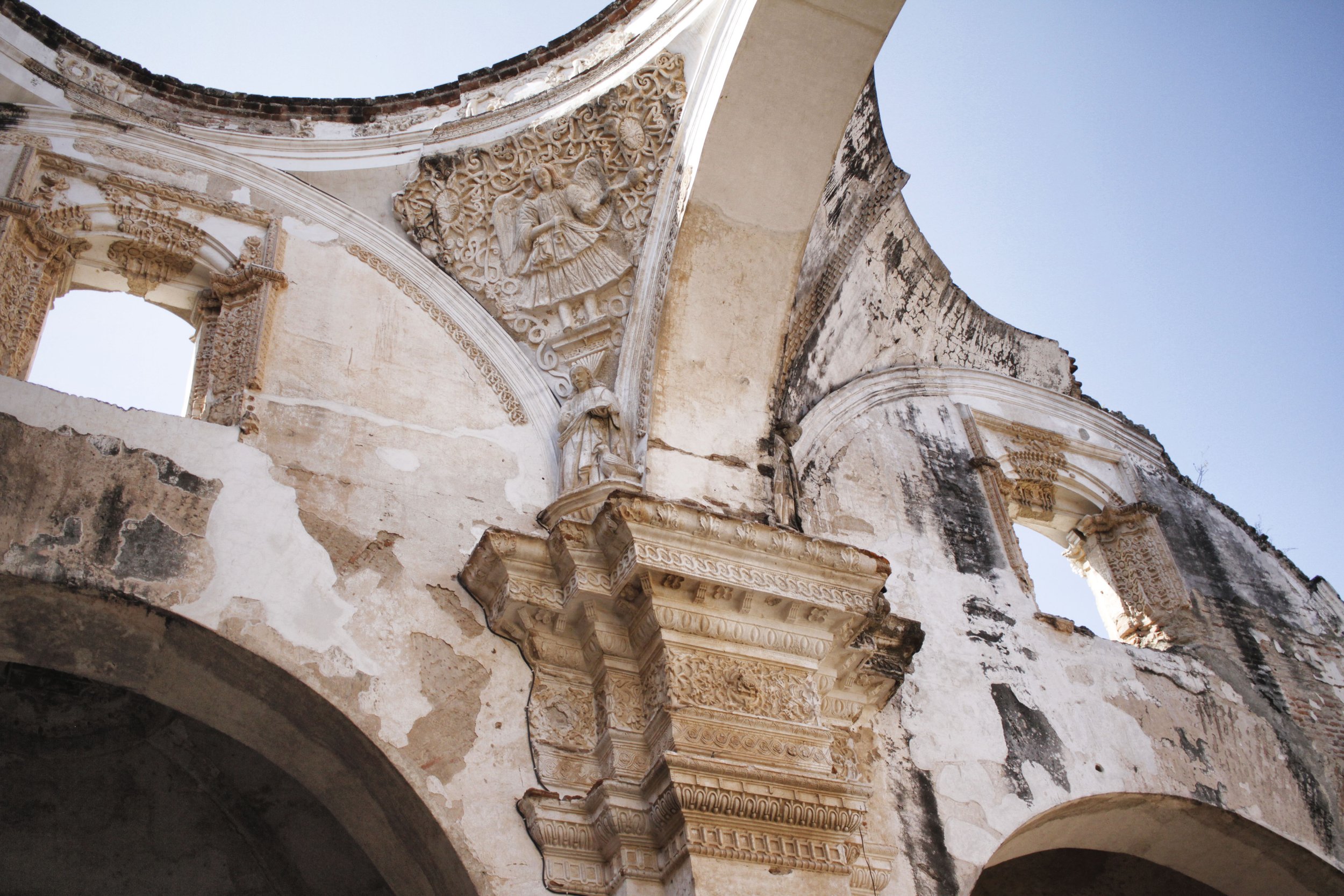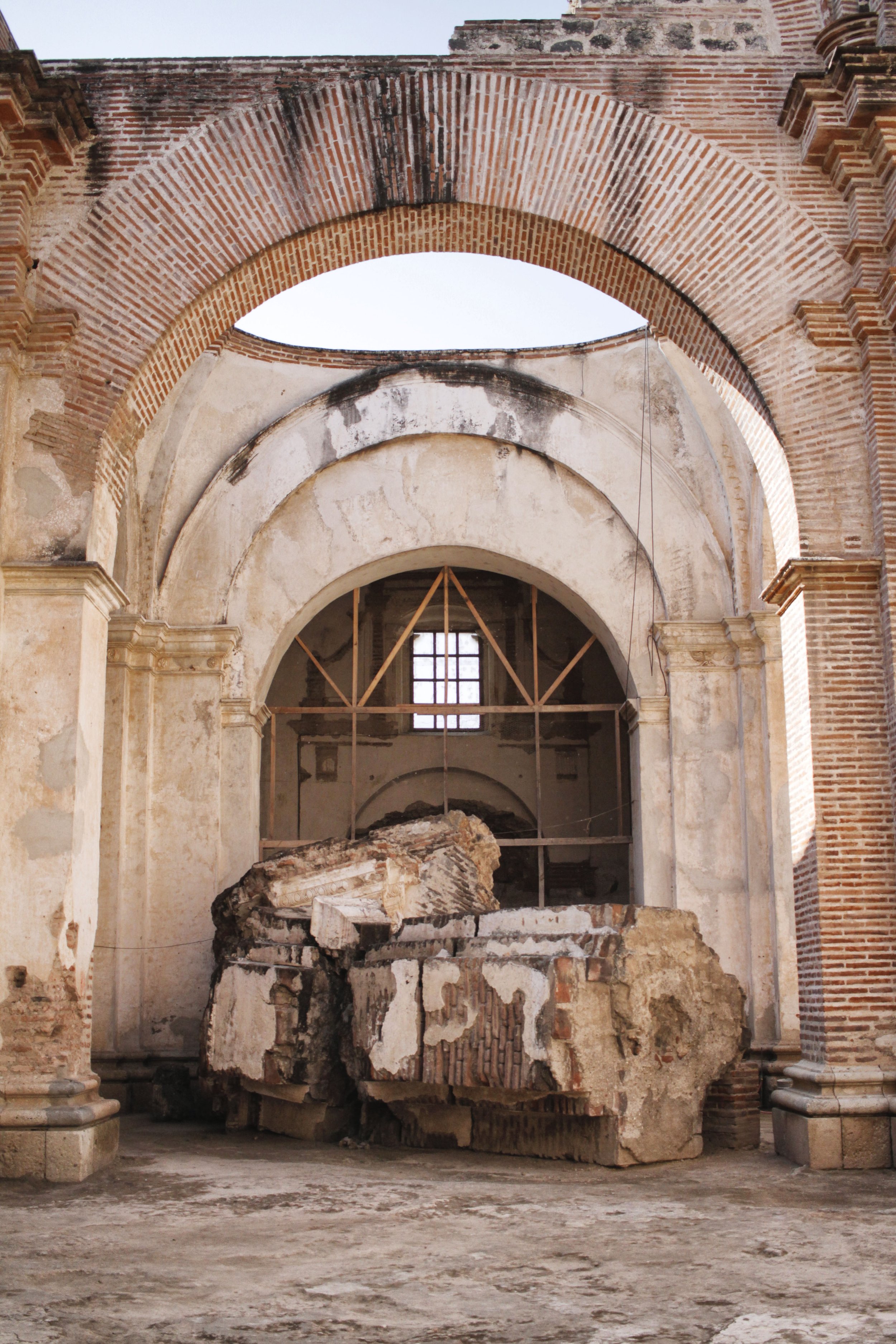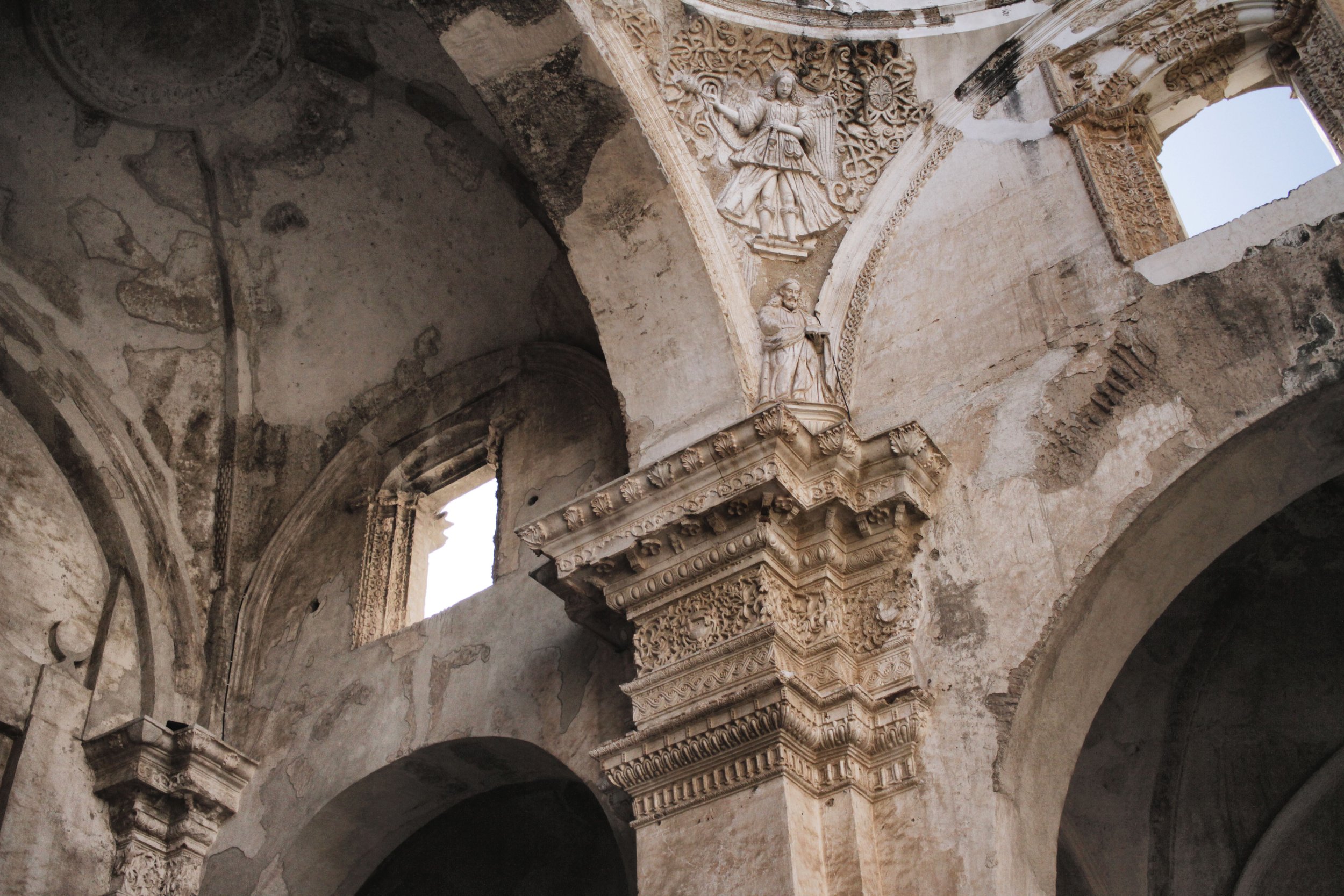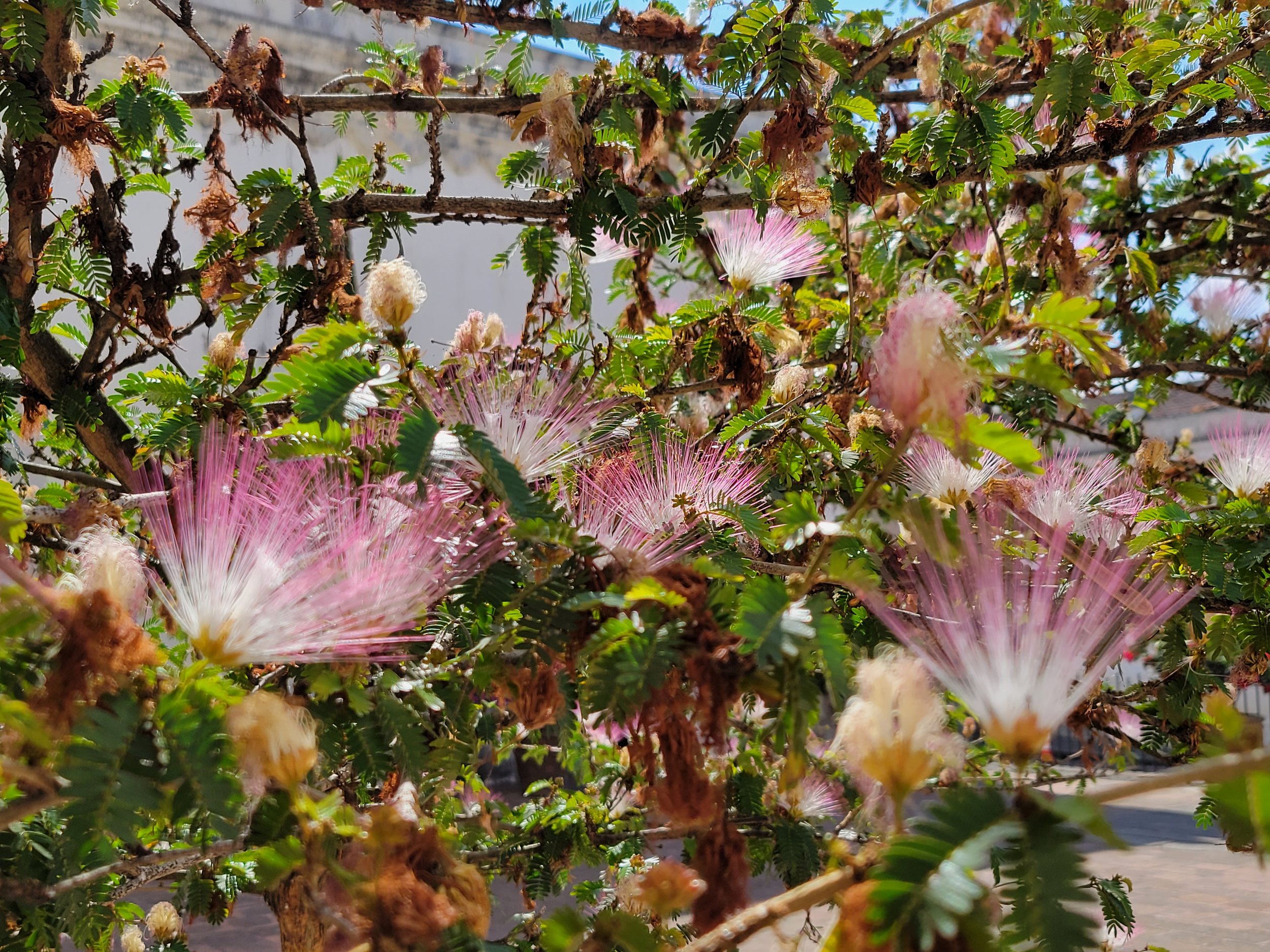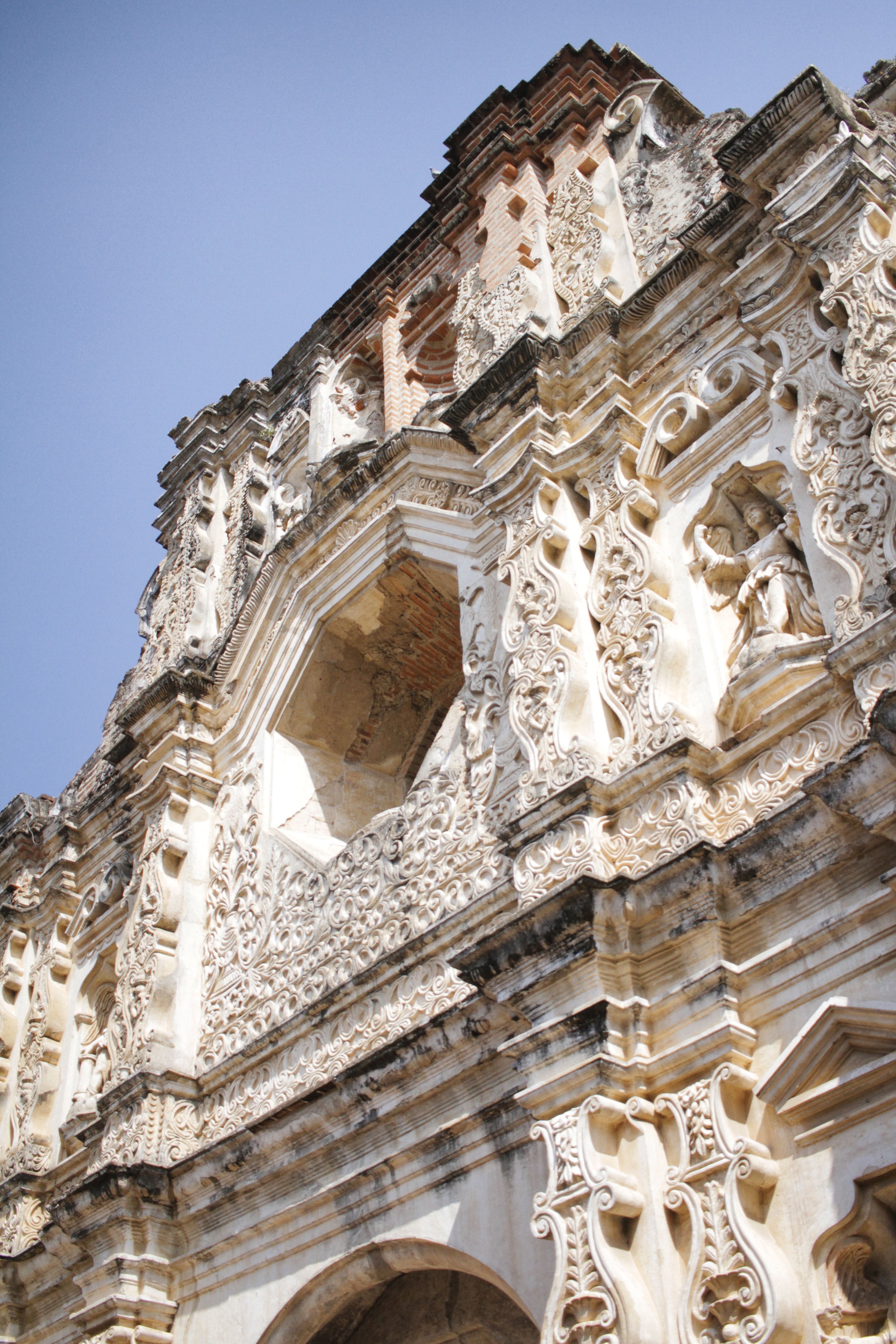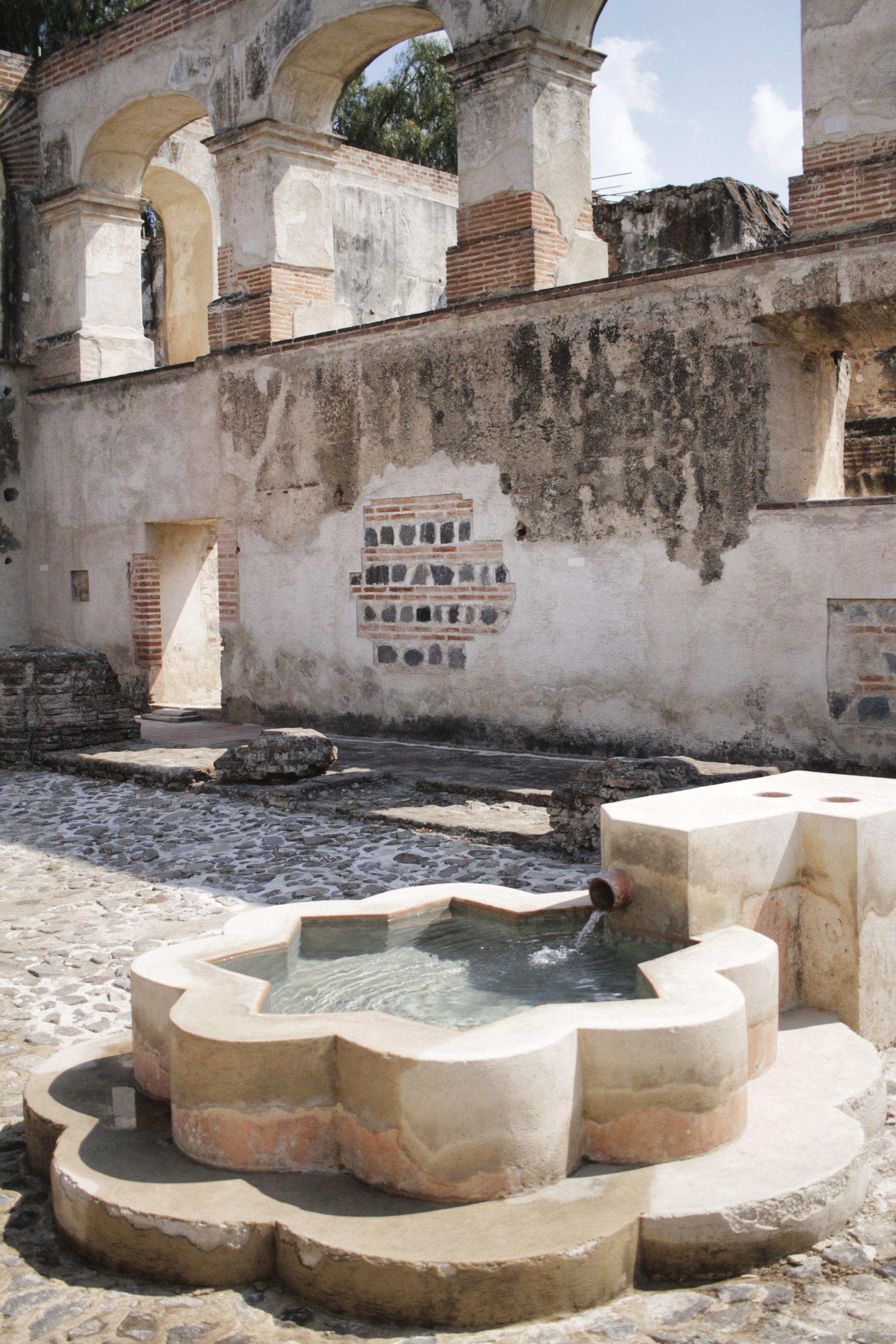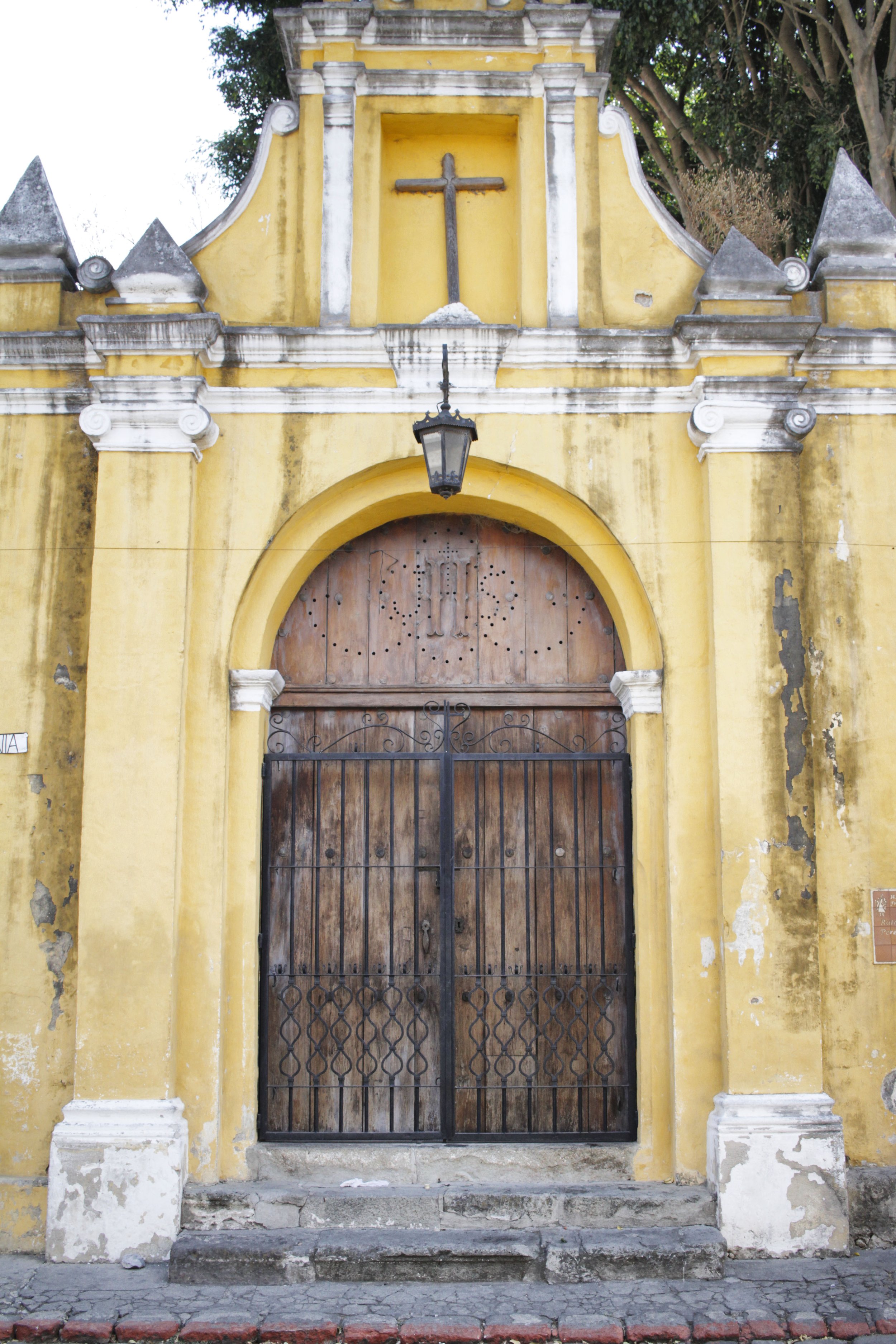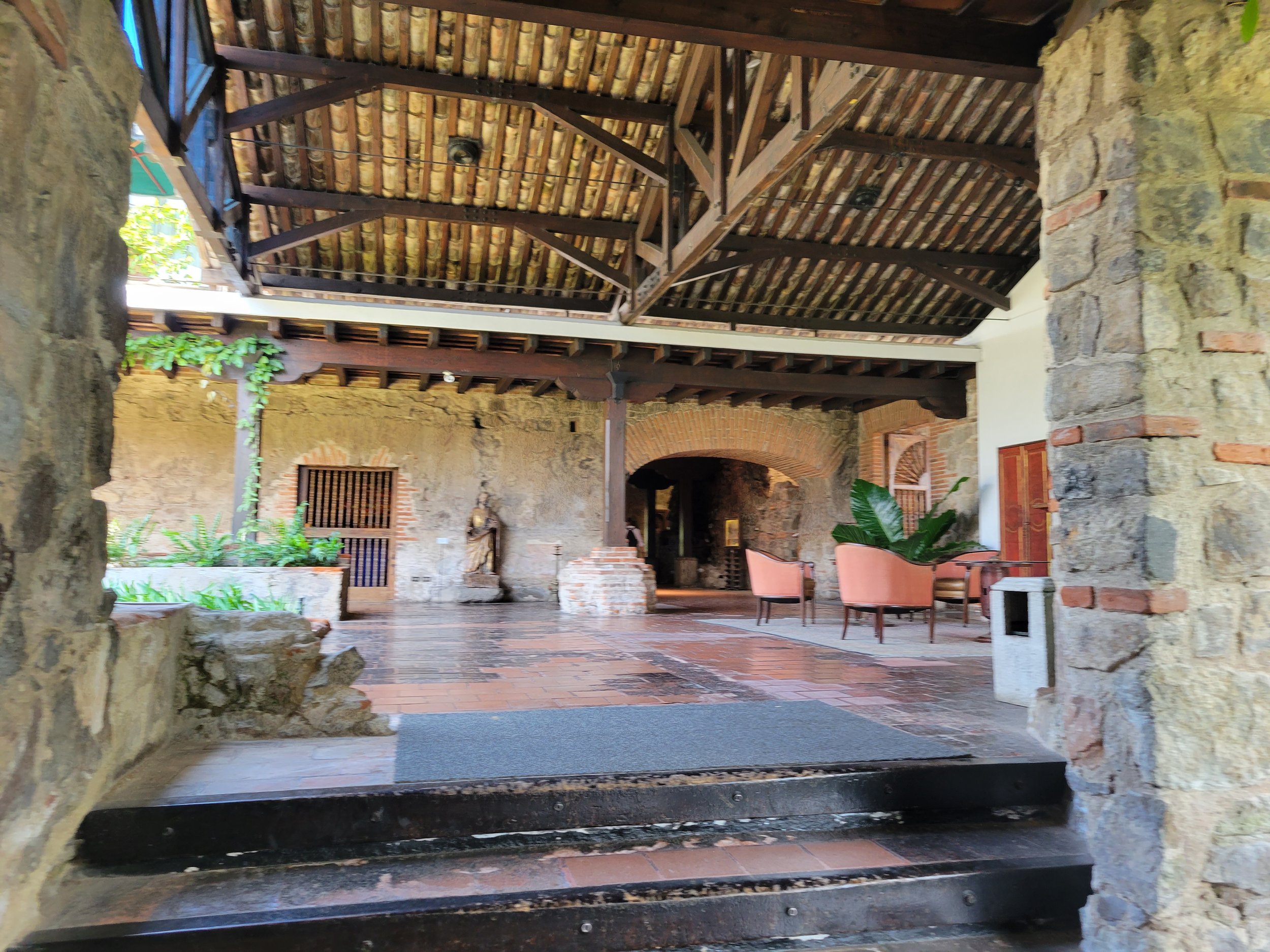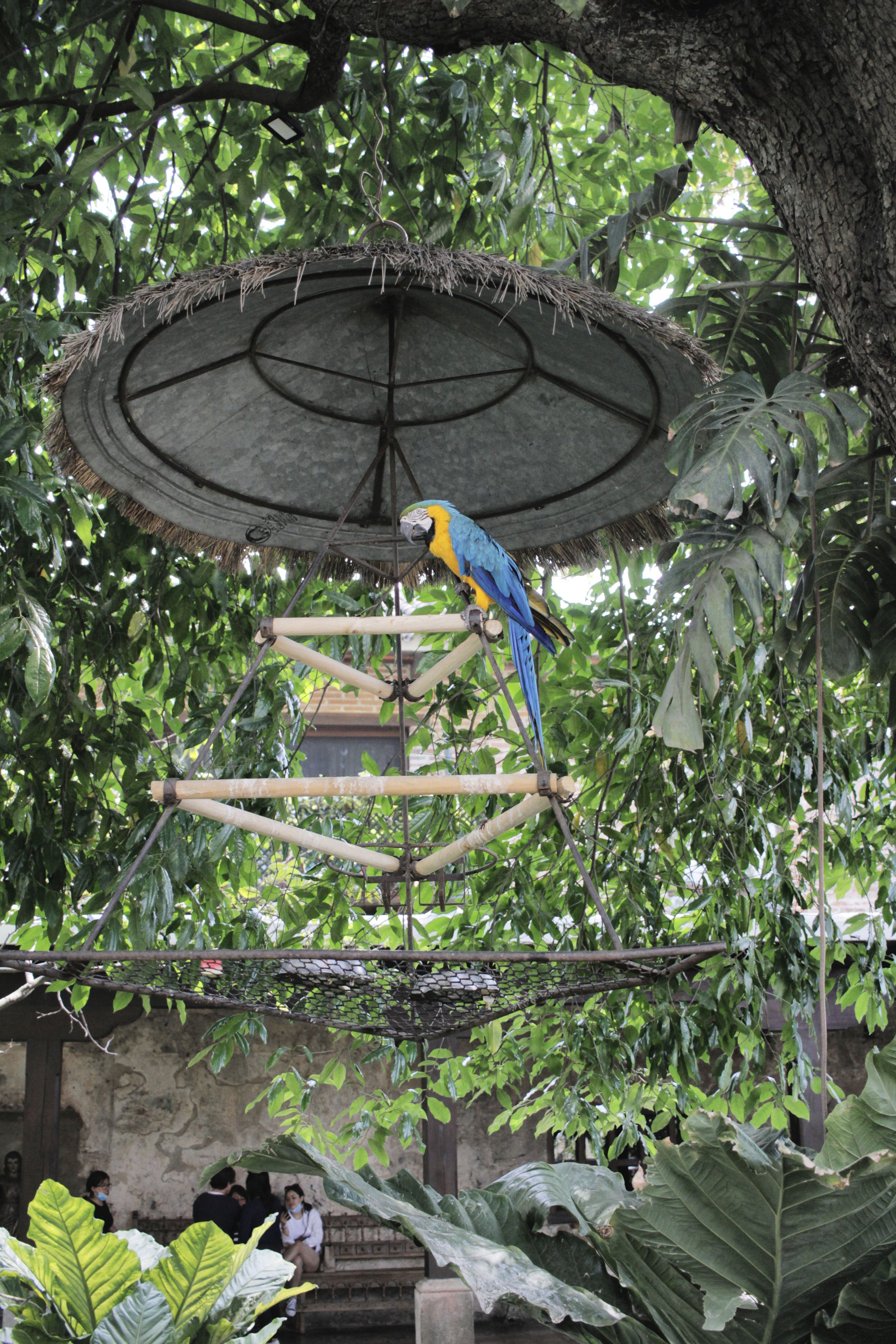Candy Colored Colonial City of Antigua
Best things to do in Antigua: uncover Spanish colonial architecture, cobblestone streets & dramatic volcano views with this travel guide.
Guatemala, “Land of Many Trees,” is the largest country in Central America and known for its richly volcanic landscape, fascinating Mayan culture and colorful colonial city of Antigua.
Inhabited for over 20,000 years, Guatemala has a long and turbulent history. Much before Spanish conquistadors arrived, the land was ruled by Mayan kingdoms.
Today, there are over 5,000 archaeological sites giving evidence of these pre-Columbian civilizations; a history buffs dream come true.
A country with a kind warm energy and a penchant for delicious coffee and chocolate; Guatemala will not disappoint.
Antigua, founded in the early 16th century, is a small city in southern Guatemala surrounded by massive volcanoes: Volcán de Agua, Volcán de Fuego and Acatenango.
Famed for its colorful Spanish colonial buildings, Antigua is charming and full of character although many of Antigua’s buildings have been restored following the destructive 1773 earthquake which ended Antigua’s 200-year reign as Guatemala’s colonial capital.
My fascination with the city lies in its robust history that’s embraced and celebrated in plain sight. Ancient ruins are scattered throughout the city, between coffee shops and produce markets.
Antigua is also a popular gateway for locals and tourists alike, with the stunning Lake Atitlán a few hours west. Formed in a massive volcanic crater, Lake Atitlán neighbors coffee fields and tiny villages worth exploring.
My adventures in Guatemala began with a few bumps, namely, a missed flight and multiple trips back and forth to LAX, but was well worth it once I felt that warm Antiguan air against my face.
Flying into Guatemala City, Antigua can be reached by taxi in under an hour for $35 USD. Spending a few days wandering its cobblestone streets in search of its charm is a must.
Next, I was off to Lake Atitlán to explore Mayan villages and volcanic crater lakes.
Later, I linked up with a local guide back in Antigua to tour its indigenous villages in search of macadamia nuts, textile markets and authentic Guatemalan fare.
Last but definitely not least, my final destination took me to Tikal National Park, a hidden ancient Mayan civilization in northern Guatemala, using Flores as my home base.
Best Things to Do in Antigua
Arrive / In the bewitching city of Antigua
Discover / The gem that is Good Hotel
Admire / Plaza Mayor
Lunch / At vegan spot, Once Once
Sample / All things chocolate at Ek Chuah
Devour / A traditional breakfast at Fat Cat
Roam / The gorgeous Catedral de San José
Enjoy / The Tranquil Temple & Convento Santa Clara
Spot / A chicken bus & visit Iglesia San Francisco
Explore / Paseo de los Museos
Uncover / Igelesia & Convento de las Capuchinas
Unwind / With some sweet treats & retail therapy
Appreciate / The canary-colored Church San Pedro Apostol
Dine / At Maxán
Track Down / Authentic Guatemalan coffee & tea
Best Things to Do in Antigua
Arrive in the Bewitching City of Antigua
Arriving in Antigua was quite magical but took a moment to get settled. A mix up with my flight and hotel had me staying half a day in a beautiful Airbnb right in the city center near Santa Catalina Arch before swapping to my final stay at Good Hotel.
What I noticed first were the rich colors and textures, along with the clear blue skies and charming architecture using natural materials like brick, tile, stucco, iron and wood.
Nearby, the Arch of Santa Catalina is one of Antigua’s most recognizable landmarks and it’s easy to understand why. Set above a busy cobblestone street, the crisp yellow arch perfectly frames Agua Volcano beyond. Built in the 1690’s, it originally connected the Santa Catalina convent to a school, allowing the nuns to pass from one building to another, avoiding the street below.
Surrounding the landmark, you’ll find a busy city center full of vendors, locals and tourists going about their day, running errands, rushing off to school or simply people watching. Picking up a snack of fresh fruit, I made my way to a local spot for breakfast.
For my first meal in Antigua, Rainbow Cafe, located on the opposite side of Parque Central (Plaza Mayor), which was a perfect way to begin the day. After taking a seat in the courtyard, I ordered a mixed fruit smoothie and a special coffee drink called Leche Krishna with milk, honey, vanilla, banana and espresso.
For breakfast, it was the Antigueno with bacon, blistered tomatoes, black beans, scrambled eggs, handmade tortillas and crema. The cafe was super cute, with a sunny courtyard, lots of greenery and a small gift shop in the front entryway. The vibe was relaxed, warm and welcoming. The meal was perfect and cost about $15 USD.
Discover the Gem That Is Good Hotel
From there, it was time to move on to Good Hotel. A short walk from Parque Central, Good Hotel lies at what feels like the edge of town on Calle del Hermano Pedro 12. This private mansion turned boutique hotel prides itself on offering premium hospitality with a cause.
Good Hotel is a social business with 100% of profits going to help those in need. They are also incredibly conscious about how they build and maintain their hotel(s), namely by supporting local partners and craftsmen. From the food they serve, to the furniture in each room, it has all been sourced locally and sustainably. Good Hotel also helps develop talent by providing long-term unemployed locals with an opportunity to build a career in hospitality.
When guests stay at Good Hotel, all return on sales goes to Niños de Guatemala, a foundation co-founded by Marten Dresen in 2007, founder of Good Hotel. this group helps provide underprivileged local children with an education. Currently, there are two primary schools and one secondary school housing over 600 children who would otherwise not have access to school.
Throughout the hotel, there are large scale photos of the children you’re helping and during check out they’ll give you a slip of paper sharing how many days of school you’ve provided a little one with. Talk about tugging on my heart strings.
On top of all this, the space is stunning. At the entry, there’s a lounge and small gift shop with locally handmade jewelry leading into a long corridor flanking a lush courtyard. Halfway down the corridor is reception, some additional lounge seating and another area displaying handmade textiles, jackets and tops.
Reception can also be used to cut through to their sister restaurant, Saúl, which is absolutely worth a visit. Not only was it super cute but the food and drinks were very tasty (even the takeaway coffee was delicious).
Minimalistic in design, this re-purposed mansion turned chic contemporary hotel is infused with warm local touches like natural materials and handmade details. Inside my room it was bright, crisp and clean. A huge photo of Astrid, one of the local children, sat above my bed.
Perhaps one of my favorite touches was the tiny worry doll placed on my pillow. A local Mayan legend, worry dolls also called trouble dolls or muñeca quitapena, are small handmade dolls originating from Guatemala.
According to legend, children tell their worries to the doll and then place it underneath their pillow while they sleep at night. By morning the dolls have given them the wisdom and knowledge to end their worries. You’ll see these dolls sold all over town, making a really sweet gift for loved ones at home.
My room also had a small patio dripping in sunlight and a gorgeously modern washroom with toiletries that smelled of citrus and brown sugar.
Reception was helpful in setting up a few tours in the coming days, as well. Destinations of interest were exploring the surrounding villages of Antigua, heading over to Lake Atitlán and the Chichicastenango Market. In the end, Chichicastenango Market was a bit too far, almost three hours each way, so that didn’t work out but the other adventures were successful. Getting up to Tikal was also important but required a bit more coordination with a flight to Flores.
Admire Plaza Mayor
Founded in 1524 and originally called Santiago de los Caballeros de Guatemala, Antigua was the country’s first capital. Located in the central highlands of Guatemala, Antigua has a long history of disasters. Serving as Guatemala’s capital for almost 300 years until 1773, Antigua was abandoned by crown officials after a series of devastating volcanic eruptions, earthquakes and floods.
But by the mid 1800’s farmers began to take note of Antigua’s rich volcanic soils, drawing them back in to the area for coffee and grain production. The city began to thrive once again and it was during this time that the Santa Catalina Arch received its domed clock tower, becoming Antigua’s most iconic monument. Finally, in 1979 UNESCO named Antigua a World Heritage site, promising the protection of its architectural and cultural legacy.
Antigua’s Parque Central was shaped after a classical colonial Spanish design with the main plaza at the center of a grid layout. Over the years, it has had many uses such as a center for official celebrations and announcements, public punishments and executions, military exercises and parades but eventually found its purpose in the 20th century as a green space resembling those found in Europe.
Today, Parque Central is the main gathering area for the city and best spot to people watch, pick up local treats or even visit an ATM (beware, they don’t always spit out the cash).
A main attraction in central plaza, a gorgeous fountain was commissioned by architect Diego de Porres and finished in 1738. Inspired by the Fountain of Neptune in Bologna, Italy, Fuente de las Sirenas or Fountain of the Sirens was installed at the center of the plaza and praised for its design and craftsmanship.
On any given day, you’ll find dozens of visitors enjoying the plaza, comingling among the pigeons and resting under the flowering trees.
Lunch at Vegan Spot, Once Once
After reading rave reviews about vegan spot, Once Once, I knew I had to give it a try. Although it was fairly busy and transitioning between lunch and dinner menus, it was a great experience.
Inside, the space was quirky and cute with a large courtyard at the center. Bright pops of color, handmade décor and even a restaurant puppy made the space feel casual and inviting. As I sat at the edge of the courtyard, a server brought over a delicious warm mug of broth, which honestly may have been the best part of the meal, not to mention the greenery and gorgeous open air patio.
A beautiful lemonade with cucumber and mint landed on the table, as well as a mushroom appetizer and veggie spring rolls.
The mushroom dish wasn’t my favorite but the spring rolls were tasty and all in all, a very lovely experience.
Sample All Things Chocolate at Ek Chuah
Although Guatemalan chocolate has been booming as of late, particularly over the last 10 years, it has an ancient history dating back much further. In fact, Guatemala is often called the birthplace of chocolate where the ancient Mayans considered cacao a gift from the gods. But it was actually the ancient Olmecs of Mexico who first domesticated the variety of cacao known as criollo. It was then brought south to the land of the Maya in Guatemala. Because the Olmecs didn’t have a written language, it was the Maya who documented their processing of cacao and more often get the credit for its early cultivation.
For the Mayan people, cacao became indispensable, first ground and then mixed with water, corn, honey and sometimes chili. At the time, it was reserved for the elite but today artisanal varieties are the norm and Ek Chuah is a wonderful shop celebrating all things chocolate.
Not only a storefront selling countless varieties of chocolate bars, beauty products and even chocolate flavored liquor, Ek Chuah is also a center for chocolate workshops where they teach the chocolate making steps beginning with the cocoa bean all the way through to a delicious chocolate bar. As I often do, I picked up some of my favorite treats like cocoa, chocolate tea, spices and a few chocolate bars, all for $25 USD.
Just outside the chocolate shop and down the street from the main plaza, live music was dancing in the warm air. An open air market spread across the cobblestone street.
It was a lively atmosphere, especially for a Sunday, paired with a gorgeous golden sunset and puffy white clouds pushing against the volcano in the distance.
Devour a Traditional Breakfast at Fat Cat
Considered one of the top 10 specialty coffee shops in Guatemala, Fat Cat honors local farmers, roasting in small batches to ensure freshness in every cup. Luckily for me they also offer a great traditional breakfast that’s quick and easy.
The little café was filled with customers enjoying the morning. Squeezing into a bar seat at the back, I ordered a rich and delicious dirty chai latte and spread of scrambled eggs, plantains, black beans, toast, salsa and cream.
The meal was fairly simple but very tasty, especially the fresh french bread.
Roam the Gorgeous Catedral de San José
One of the most prominent cathedrals in Antigua, Catedral de San José, sits on the east side of the main plaza across from the Fountain of the Sirens. Initially, it was a bit confusing to find the entrance as it’s south of the front façade and around the corner but absolutely worth the confusion.
Dating back to 1545, the Antigua Cathedral, as it was previously known, was built of stone and a tile roof. Due to its overall condition and need for greater beauty and grandeur it was demolished in 1669. It was then rebuilt in 1680 by architect Joseph de Porres but damaged by earthquakes in 1717 and 1751, repaired on both occasions. Finally, in 1773 the cathedral was seriously damaged yet again by a devastating earthquake which also destroyed many of Antigua’s oldest buildings.
When the capital city moved from Antigua to Guatemala City, repairs ceased. Then in the 19th century, the abandoned building was converted into the Parish of San José, by demolishing the ruined parts and remodeling others. The front face of the cathedral still stands strong as a striking example of colonial architecture but step behind its façade and you’ll see the bones of a haunting, roofless structure.
To enter the cathedral, walk around the southern side and find the entrance gate charging 20 Guatemalan quetzals, about $2.50 USD. Also worth nothing, my time in the cathedral was particularly special because the early morning hour offered a still moment to explore, being the only person inside other than the groundskeeper, along with cooler temperatures.
Upon entering, the scale of the arches and domes was absolutely overwhelming, especially paired against the soft blue sky. As I moved from room to room, the light and shadows flickered silently against the dusty dirt floor and I enjoyed every moment.
Inside the cathedral, there were various chapels, alters and choir locations with two of those chapels being restored at the beginning of the 19th century. To the right of the entry was a crypt beneath the structure, in addition to a set of tunnels whose use is unknown.
Stepping down into the dark moist crypt was daunting at first but was lit from inside, offering a little comfort.
Inside the crypt were several large pieces of carved wood on display, priceless artifacts from the original cathedral.
Dipping back into the sunlight, I began to once again wander the grounds of the cathedral. The still silent energy of the space was peaceful and a welcome retreat.
The cathedral also houses the remains of the conqueror Pedro de Alvarado, Spanish conquistador and governor of Guatemala who participated in the conquest of Cuba, Juan de Grijalva's exploration of the coasts of the Yucatán Peninsula and the Gulf of Mexico and the conquest of the Aztec Empire led by Hernán Cortés.
The open skies brought fresh air into the walls of the cathedral; I surely prefer the roofless structure rather than one covered up, pigeons and all.
Before leaving this sacred space, I asked the groundskeeper to snap a photo of me to remember my time there and the sheer scale of the space. Catching my breathe from such a lovely experience, I began to roam the sunny streets of Antigua once again. (Southern entrance gate seen below.)
Almost immediately, I stumbled upon a super cute shop called Cuna de Maestros Artesanos. The shop keeper was incredibly kind and helped me pick out a few gorgeous items. There were all kinds of jewelry, stones, metalwork, accessories and home goods.
In the end, I chose a jade face roller meant to gently massage skin and stimulate circulation, along with a handmade woven necklace and brightly colored napkin rings with tassels. And I decided this was one of my favorite stops in Antigua because the items were so unique and well made.
Enjoy the Tranquil Temple & Convento Santa Clara
As I headed south, it wasn’t long before bumping into another special site worth exploring.
The sun soaked streets lead me to the Convento Santa Clara, where remains of a religious complex from the 1700s feature a church with an ornate façade. Initially, I wasn’t sold on entering for the 40 quetzals fee (about $5 USD) but was pleasantly surprised with its beauty after walking through an unassuming entrance off the main street.
Covering an entire city block, the grounds were enormous and offered respite from the busy streets outside. Construction of this church and convent was completed in 1705, though the founding nuns had arrived in Antigua in 1699 from Mexico. The earthquakes of 1717 destroyed the original building but a few years later, architect Diego de Porres began new construction, ultimately finishing in 1734 with none of the original remains in tact.
The façade of the temple lies inside the convent, as it used to be closed to the public, the nuns never leaving its walls. This façade is also one of the most beautiful in Antigua, richly decorated with stucco pilasters, a very unique feature in baroque Antiguan style.
The main cloister of the convent is spacious, with gorgeous proportions and arcades on two levels. In the center of the courtyard is a fountain carved of stone. On the ground floor of the convent was sacristy, dining room, kitchen and work room, along with cells used for the nuns.
My best part of the temple and convent was all the green plant life and bright magenta flowers contrasting against the soft white stone and bright blue sky. The grounds were pristine, in perfect condition, without so much as a leaf on the lawn.
It was so peaceful, with several water fountains and lush plant life throughout, a mix of history and present day life. All the green softened the architecture and welcomed guests.
One of the most interesting monuments in the city, Santa Clara did not disappoint.
If it were only possible to stay the day, spread out a blanket out on the lawn and enjoy a picnic, I would have.
Spot a Chicken Bus & Visit Iglesia San Francisco
Just a few short blocks away sat another gorgeous church and on the way I caught a sighting of a chicken bus zipping through the streets.
Known as chicken buses by visitors because they often transport live chickens and other animals from one place to another, these brightly colored busses aren't just about animals. A wide variety of goods like potatoes or corn are also carried, along with being the main form of public transportation in Guatemala.
A genuine window into Guatemalan life, these busses are quick, cheap and used by locals regularly. Often old American school buses fixed up and tricked out, these busses are a great source of pride for their drivers who take the risk of owning such a vehicle, working long hours, hoping to provide a better life for their families.
San Francisco el Grande is a church in Antigua frequented by locals looking to visit the shrine of Peter of Saint Joseph Betancur. His tomb is visited by thousands of pilgrims each year who beg for favors and miracles.
The façade, with its spiraling twisted columns, is common for the Spanish-American baroque style of architecture, similar to San José Cathedral. It has sixteen vaulted niches, with all but the lower two containing a saint or friar including the Virgin Mary, San Diego de Alcalá, San Antonio de Padua, San Juan Capistrano, Santa Clara, Santiago and Santa Isabel from Hungary.
In 1565, damages to a different church built by Franciscan missionaries who had arrived from Spain in 1530, lead to ten years of donations in order to build a new sanctuary located only two blocks away, San Francisco el Grande. Part of this new construction may be the only ones in Antigua dating back to the 16th century, and can be admired on one side of the sanctuary today.
Over time, San Francisco el Grande became a significant religious and cultural center for the entire region. Located within the monastery ruins, San Buenaventury College taught subjects such as theology, law, philosophy, physics and mathematics. The college has also favored painters of the colonial era like Cristóbal de Villalpando, Thomas de Merlo and Alonzo de la Paz.
With a quick peak inside, I viewed worshipers moving forward on their knees toward the front of the church in prayer. Figuring it best to leave them in peace, I was off to visit a young boy selling ice cream in the lot nearby. I chose vanilla ice cream drizzled with raspberry sauce.
There were also a handful of vendors set up in stalls, selling all kinds of trinkets, souvenirs and sweet snacks.
Explore Paseo de los Museos
A few minutes walk from the city center is Hotel Casa Santo Domingo, and inside this hotel lies six permanent museums and two rotating art exhibits in what was once Santo Domingo Convent. Santo Domingo Church and Monastery is a ruined monastery with history dating back to 1538 when Dominicans first arrived in Guatemala. Today, part of the ruins have been transformed into a hotel where visitors are able to book a room or explore the site.
Once past the main hotel amenities, the skies open and ancient ruins begin to appear, not to mention a few gorgeous parrots hanging in the massive trees.
Originally, the monastery had two towers with ten bells and was filled with treasures but was ultimately destroyed in the 1773 Santa Marta earthquake. Its these ruins that are on display as part of the hotel grounds.
To enter, there’s a small fee of 48 quetzals, along with signs displaying information about the location. Formed by four corridors with columns supporting the arcades, the central portion of the main cloister and fountain has an octagonal pond set inside a square that forms triangles on which remains of “al fresco” paintings display mosaics in several colors.
Next to that area, a chocolate shop sells all kinds of delicious treats. Even if you’re not picking something up, it’s a great place to cool off for a few moments and sample some chocolate. Just make sure to eat it quickly so it doesn’t melt in your hands.
Continuing on, a small crypt underground displayed two skeletons. Burials are always done with the head placed to the east and feet to the west. Remains of a man and woman along with wood, material and nails were found under the floor of the church.
From there, deeper into the grounds there was a church and number of museums including the Archeological Museum which holds ceramic and stone objects from the Classic period of Mayan culture.
The life of Mayan individuals was compared to that of gods, so they were surrounded by rituals and artifacts used to take part in those rituals. Inside the museum were countless displays of carved stone, jewelry, pottery and artwork.
The next building over housed an exhibit of more traditional artwork, namely, photography from artists Sergio Cruz and Danny Gamboa. It marched around the room, one by one, some color and others, black and white.
In the center of the room were a few large scale sculptures along with a number of buried artifacts under the main floor.
Uncover Igelesia & Convento de las Capuchinas
Igelesia & Convento de las Capuchinas was one of my favorite sites to explore but smaller than anticipated. The building complex, originally called "Convento e Iglesia de Nuestra Señora del Pilar de Zaragoza" or Convent and Church of Our Lady of Zaragoza, is one of the best examples of an 18th century convent in Guatemala.
Approved by Felipe V in 1725, construction began in 1731. Blessed under architect Diego de Porres, this was the last convent to be built in the city and the first that abandoned the habit of demanding a dowry for new nuns, a rule that had prevented poor women from joining religious life.
Life of the nuns and daily routines were ruled by very strict regulations including penance and fasting. But, important to note, with the arrival of this convent, two types of nuns emerged: the discalced (barefoot) nun and the urban nun.
Discalced or barefoot nuns had a much tougher life than urban nuns as they were not able to provide an admission fee of goods or property upon entering the nunnery. Though both living an enclosed life, the discalced nuns had stricter rules such as practicing silence, except to pray, and never drinking chocolate or eating meat. They occupied smaller cells, performed all the chores and dressed in simple clothing and footwear.
The convent held up to 28 nuns, all under the supervision of an abbess. In the basement, a white painted room was used for nuns to gather and sing. These sounds carried up into the convent and each bedroom through a system of pipes.
At its center is a “retirement tower” with a circular structural base in the form of a mushroom about 10 feet in diameter, the only one in the Americas during the colonial era. The convent was designed to allow panoptic views where the entire interior can be seen from a central point. This allowed for maximum observance of the nuns.
The Circular Building or cloister on the east side of the grounds is surrounded by cells for each of the nuns where they were provided with a simple bed, small table and chair, along with a private toilet and study area.
Although not entirely affected, in the wake of the 1773 Santa Marta earthquakes the convent was abandoned, moving its contents and nuns to the new capital.
Unwind with Some Sweet Treats & Retail Therapy
For sweet treats and candies, Dona Maria Gordillo Dulces Tipicos offers the best. A sweets shop selling special Guatemalan candies and confections since 1872, this spot is worth a visit. Typically overflowing with guests waiting in line to get their hands on some delicious candies, I was lucky enough to arrive during a slow moment.
With walls lined in brightly colored ceramic owls, this candy shop was super fun, even the candies had so much character. Requesting the most typical candies and traditional treats, the woman inside was happy to pick out a few of the must-haves for me. Sticky and gooey, my selections included varieties of toasted coconut, milk and sugar and coffee flavors, all of which were incredible.
Nearby, adorable coffee shop, 12 | Onzas, sells hot and cold beverages, alike. To cool down, I picked up a lemonade and soda with tamarind called El Lindo.
Right on 3a Avenida, La Tienda de Doña Gavi is one of the most unique shops in Antigua. This apothecary slash ice cream shop was so cool and bizarre, especially given the unassuming appearance street side.
Once inside, there were so many interesting objects including a giant candle with drippings so massive it looked as if it had been burning for years. Hard to tell which items were for sale and which were simply eye candy, was half the fun.
There were soaps, lotions and potions of all kinds and even a wide variety of flavorful homemade ice creams. The guanabana (soursop) ice cream was very refreshing.
My absolute favorite shop in Antigua was Wakami. This ethical fashion accessories brand connects local producing communities to global markets, with products that tell stories and reflect our collective love for the Earth. Partnering with women from rural communities in Guatemala, Wakami helps to inspire artisans to make their dreams come true.
Inside the shop, there were various spaces highlighting different types of goods. Everything was clean, fresh and handmade from local women with natural fibers and materials. Wakami believes earning an income is a fundamental human right and works to empower the women involved. A real connection between the people and land is also highlighted, with inspiration from local volcanoes, lakes and landscapes that make Guatemala such a gorgeous country.
For a late lunch, I stopped in Union Cafe. This all day breakfast and lunch spot serves up locally sourced Guatemalan coffee, yummy smoothies and takes a fresh approach to healthy food with many vegan options available. Plus, the interior is absolutely adorable.
The Hulk was my smoothie choice, made with milk, banana, avocado, swiss chard, homemade peanut butter and chia seeds. To eat, the falafel bowl with falafel, hummus, cucumber, celery, carrot, eggs, beans, sweet potato, shallots, cheese, avocado, pumpkin seeds, chia and a spicy yogurt sauce. The falafel and hummus were the highlights of the meal.
Another special treat while in Antigua was meeting Manuel. This young boy was on a street corner selling nuts to passersby. For 40 quetzals or about $5 USD, he pulled together a mixed bag including cashews, macadamias, lima beans and others, all of which were incredible.
After the sale, I spent a few minutes hanging with Manuel and learned he was 16 years old but not in school. He’d been selling nuts to help his family earn some extra income. Before taking off, he asked for a selfie with the two of us. Talk about a cutie pie.
Appreciate the Canary-Colored Church San Pedro Apostol
Another special church in Antigua is Church San Pedro Apostol, a small yet detailed structure sitting next to a green grassy area used as a small park.
The pale yellow canary color and crisp white details were stunning against the sky.
Next to the church were a handful of dogs hanging out in the sun under the enormous palm trees. Pretty typical for Antigua, dogs roam free outside during the day but are cared for by locals who offer food and water.
I loved seeing the dogs gather and hang as if they were discussing their weekend plans.
Dine at Maxán
One of my favorite meals was at a relatively undiscovered gem called Maxán. Maxán is a Mesoamerican fusion restaurant with a creative kitchen and fresh flavors. It’s also got a really great space too, full of green plants, eclectic design and bright colors. For dinner, I tried the shrimp ceviche and guacamole with chips, along with a delicious cocktail. Everything was very tasty and the seat up front in the open window was perfect.
The following morning I set up a day trip to visit Mayan villages and the volcanic crater lake, Lake Atitlán. This body of water is known as the deepest in Central America and lies about two hours west of Antigua.
After a long day touring the villages surrounding Lake Atitlán, Saúl Bistro Antigua offered an easy meal, location-wise. Saúl is connected to my hotel, Good Hotel, and boasts a fresh new menu every six months to stay innovative. It’s also quite romantic.
Though prices seemed a bit high, my meal was excellent, the Bistrology salad and Hierba Muy Buena smoothie with blackberry, mint, melon and cardamom. The salad in particular may have been the best I've ever had. It was incredible, along with a delicious chai soy latte to go.
The following day was spent with a local guide visiting the surrounding villages of Antigua discovering a macadamia nut farm, textile shops and traditional Guatemalan food.
Track Down Authentic Guatemalan Coffee & Tea
As my time in Antigua began to wind down, my final evening was spent scouring the neighborhood for some delicious coffee and tea to bring home.
For high quality coffee options, my guide recommended stopping in Jade Coffee. It was there I found the most delicious Geisha coffee beans. Guatemalan Geisha coffee is a scarce and ancient coffee of wild Ethiopian origin. This single-origin low acid coffee comes from small farms in San Marcos, Guatemala at an altitude of 7,700 feet. The flavor notes include citrus, jasmine, praline and lime with a smooth sweet floral feel.
Up next, was Pachamama Blends, a coffee and tea house specializing in unique blends. After taking a moment to explain what I was looking for and my favorite flavor profiles the shop keeper began to whip up something magical.
One mixture included mint and other herbs promoting digestion and another was a spicy chai with pink peppercorns. Happy to have discovered such a treasure, I absolutely loved this spot. The girls inside were so kind and helpful, as well. Don’t be intimidated, just dive right in.
The next morning, after a quick bite at Arista de Cafe, I jumped into a taxi toward the airport for $40 USD. My flight to Flores was taking off soon and I was excited to settle in and get ready for my next adventure at Tikal National Park.
The coffee shop was super cute inside but I was anxious to get on the road. I ordered a chai latte and smoothie bowl topped with granola, fresh fruit, chia seeds and coconut.
After spending most of the day at the airport and learning domestic flights within Guatemala aren’t always on time, I was finally off, arriving at my Airbnb in Flores that evening. The following day would be spent exploring the ancient Mayan civilization hidden in the rainforests of Tikal.















